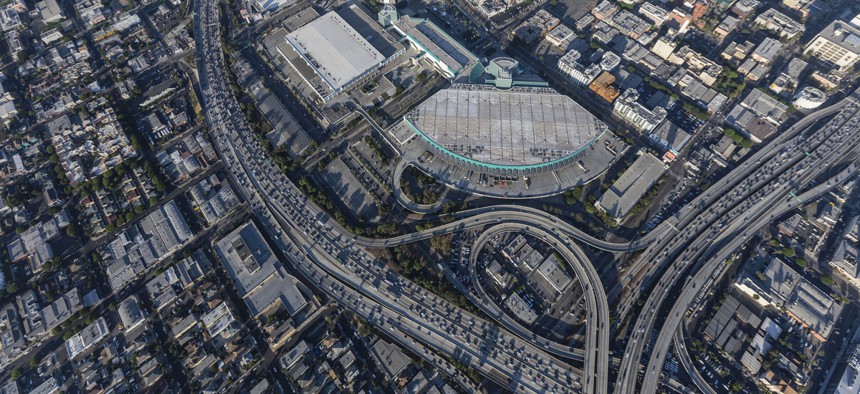L.A.'s Future May Involve More Congestion Pricing and Free Transit Service

The 10 and 110 freeways intersect near downtown Los Angeles. Shutterstock
There are “three conceivable ways” expanded tolling could work in Los Angeles, according to Metro.
The CEO of the Los Angeles County Metropolitan Transportation Authority has endorsed the idea expanding congestion pricing—aka rush-hour tolls—to more L.A.-area freeways and fund free transit service as a way to lure people out of their cars that clog those crowded roadways.
“We think that with congestion pricing done right, we can be the only city in the world to offer free transit service in time for the 2028 Olympics,” Metro CEO Phil Washington said during a Metro Board of Directors meeting on Thursday, according to Curbed LA.
Washington was discussing possible new revenue sources to fund the “28 by 28” acceleration of Metro expansion projects ahead of Los Angeles hosting the 2028 Summer Olympics. The plan includes new light-rail lines and extensions; finishing the Purple Line subway’s second and third phases to L.A.’s Westside; a transit connection through the Sepulveda Pass corridor; and new bus rapid transit lines. .
The challenge is funding the ambitious transit expansion vision that’s been put forward by L.A.-area leaders, who are looking at a variety of ways to use existing and new revenue sources.
According to a Metro presentation, there are “three conceivable ways” to implement congestion pricing in Los Angeles County.
Cordon Pricing:
Creates a boundary around a central district and charges vehicles to cross that boundary. The fee can go up or down based on demand, or be set at a specific rate for peak versus off-peak times.VMT Pricing:
Charges drivers based on Vehicle Miles Traveled (VMT) and can charge variable prices based on location and time of day.Corridor Pricing:
New concept yet to be implemented, prices all lanes on roads within a specific high-traffic congestion corridor that has a viable public transit alternative. Fees would be based on miles traveled within the corridor.
The Metro presentation noted the difficulties involved in expanding tolls: “Congestion pricing can be a challenge to implement due to political viability, technical issues and privacy and equity concerns.”
Los Angeles Mayor Eric Garcetti observed during Thursday’s board meeting, as Curbed LA reported: “The moment you say something like congestion pricing, there’s probably going to be nothing else in the headlines today.”
Other possible new revenue sources include new fees on transportation network companies like Uber and Lyft. According to the presentation: “Taxing new mobility trips should be used in carefully targeted ways designed to reduce single-occupancy travel.”
Metro’s Express Lanes along the 10 and 110 freeways offer variable-price tolling for those willing to pay to use congestion-free lanes. Similar managed toll lanes are currently in operation in places like Maryland, northern Virginia and Texas.
The transportation challenges in Los Angeles come as California is struggling to meet its goals for greenhouse gas emission reductions due to increased levels of driving, according to a recently released report from the California Air Resources Board.
“California—at the state, regional and local levels—has not yet gone far enough in making the systemic and structural changes to how we build and invest in communities that are needed to meet state climate goals,” the report said.
Expanded tolling and free public transit, as suggested by L.A. Metro’s CEO, would certainly bring about big systemic and structural changes to the ways residents of Southern California move around the region.
PREVIOUSLY on Route Fifty:
Michael Grass is Executive Editor of Route Fifty and is based in Seattle.
NEXT STORY: The Trump Administration’s Solar Tariffs Haven’t Stopped America’s Switch To Solar






